An introduction to the characteristics of Indonesian Java coffee with fragrant, full-bodied and fruity flavor manor.
Surabaya is the capital of East Java Province, with a city area of 326km ²and a population of 3.6 million. It is the second largest city in the country after Jakarta, the main naval base, one of Indonesia's important manufacturing, agricultural products processing, trade centers and the sea and air transportation hub of Java. It is known as the "Hero City" because of its heroic resistance to Britain during the struggle for independence.
Medan
Medan is the capital of North Sumatra province, with an urban area of 342 square meters and a population of about 1.8 million, making it the third largest city in Indonesia. Bordering the Strait of Malacca, it is the west gate of Indonesia's foreign trade and one of the main entry and exit ports for domestic and foreign tourists. The establishment of the economic growth triangle in Indonesia, Malaysia and Thailand has strengthened its position as the development center of Jiangsu Province and northern Indonesia. it has promoted the rapid development of the city's small industries such as food processing, textile industry, leather goods, chemical industry, building materials, metals and means of transportation. The city has a clean appearance, shady trees and a pleasant climate. The Sultan Palace in the city was built in 1888 and the Indonesian islands are scattered, mainly Kalimantan, Sumatra, Irian, Sulawesi and Java. The interior of the islands is full of rugged mountains and hills, with only narrow plains along the coast, surrounded by shallow seas and corals.
Kalimantan Island, the mountains extend from the middle to the west, the coastal plain is vast, and the south is swampy.
Sumatra Island, the mountains slant from northwest to southeast, the northeast side of the mountains are hills and wide coastal alluvial plain, the eastern part of the plain is swampy.
Sulawesi is mostly mountainous, with only narrow plains along the coast.
On the island of Java, there are plains in the north and lava plateaus and mountains in the south.
Irian Island, with high mountains in the west, has the highest peak in Indonesia and the highest island peak in the world, Chaya Peak, 5030 meters above sea level, and the southern plain is wider. According to the statistics of Indonesia's Ministry of Energy and Mines (2013), Indonesia has coal reserves of about 58 billion tons, of which 5.4 billion tons are commercially recoverable reserves. As there are still many areas with unproven reserves, the Indonesian government estimates that the total coal reserves will reach more than 90 billion tons. Indonesia has huge natural gas reserves, about 123,589 trillion cubic meters (equivalent to 20.6 billion barrels of oil), of which 2423 trillion cubic meters have been proved, mainly produced in Allen in Sumatra and Badak in East Kalimantan. Indonesia has nickel reserves of more than 5.6 million tons, ranking first in the world. Diamond reserves are about 1.5 million carats, ranking first in Asia. In addition, uranium, town, copper, Ming, bauxite, Zhong and other reserves are also very rich.
At that time, Java coffee sold to Europe was a very special kind of coffee. At that time, it was shipped to Europe and the United States by sailboat, and the distance was long and the speed was slow, so it took a lot of time to transport. In this case, the coffee seems to have undergone a special fermentation and has a very unique taste.
Later, when the ship replaced the sailboat, due to the shortened delivery time, people drank relatively fresh coffee beans. But people who are used to drinking Chen beans are not used to the fresh taste, so they desperately pursue old Java coffee, so that the Indonesian government and some businessmen deliberately store fresh beans in warehouses for one or two years and then sell them to consumers. In fact, compared with fresh beans, the acidity of aged Java beans is close to zero, but the flavor is more intense. Because of the long storage time, the increase in cost and the limited quantity, Java has always been a hot item in the coffee market. In the 1880s, some profiteers deliberately tampered with some fresh Guatemalan or Venezuelan beans to mimic the high prices of old Java. It is intolerable that profiteers dye coffee beans to make them look more like old Java, but there is no doubt that the dyed chemicals are of course toxic. Each caffeine variety has its own strong personality, such as masculine Mantenin, which resembles a steel man; mellow, fragrant blue mountain coffee, and gentle miss addictions. Java Coffee, which has always been light and fragrant, is suitable for those who like light sex. Such people do not want to drink coffee as a sitting thing, from sour, sweet, bitter, astringent experience what profound philosophy of life, just want to simply drink a cup of delicious coffee, a cup of hot Java coffee, let these people realize that "the realm of life is rich and quiet." Quiet, because of getting rid of the temptation of external fame and gain; rich, because of having the treasure of the inner spiritual world. The happiness of life is to reap such an incisive interpretation of the realm.
The sour, bitter and sweet tastes of Java coffee match well. Unique fragrance, after drinking, the aroma fills the whole mouth. Exhale the aroma from the mouth again from the nose, the smell is very full. Maybe you will find it too overbearing, because it will quickly occupy your taste buds, your mind and even your soul. Why resist it? The life we live in is full of sour, sweet, bitter and astringent, so let the smell of coffee take away everything in the world. What we enjoy is not just a cup of coffee, but also the quiet moment that coffee brings to us.

Important Notice :
前街咖啡 FrontStreet Coffee has moved to new addredd:
FrontStreet Coffee Address: 315,Donghua East Road,GuangZhou
Tel:020 38364473
- Prev

Full-bodied, mild flavor of Costa Rican coffee taste manor area characteristics
The seven provinces are: Alajuela Alajuela (central, northwest of San Jose), Catago Cartago (central, east of San Jose), Guanacaster Guanacaste (northwest), Eredia Heredia (central, north of San Jose), Limon Limn (east, along the Caribbean), Pentalenas Puntarenas (west, along the Pacific Ocean), San Jose San
- Next

An introduction to fine coffee in manor area with elegant aroma and taste of Guatemalan coffee.
Between 1950 and 1954, the ruling president Jacobo Abens implemented land reform, when big landlords, who accounted for 2 per cent of the country's population, owned about 70 per cent of the country's arable land. Arbens wrote a check for land reform, promising to buy the land held by the big landlords and redistribute it to small farmers. Arbens won the election, and the land reform plan was carried out immediately. For owning land greater than 223 British
Related
- Detailed explanation of Jadeite planting Land in Panamanian Jadeite Manor introduction to the grading system of Jadeite competitive bidding, Red bid, Green bid and Rose Summer
- Story of Coffee planting in Brenka region of Costa Rica Stonehenge Manor anaerobic heavy honey treatment of flavor mouth
- What's on the barrel of Blue Mountain Coffee beans?
- Can American coffee also pull flowers? How to use hot American style to pull out a good-looking pattern?
- Can you make a cold extract with coffee beans? What is the right proportion for cold-extracted coffee formula?
- Indonesian PWN Gold Mandrine Coffee Origin Features Flavor How to Chong? Mandolin coffee is American.
- A brief introduction to the flavor characteristics of Brazilian yellow bourbon coffee beans
- What is the effect of different water quality on the flavor of cold-extracted coffee? What kind of water is best for brewing coffee?
- Why do you think of Rose Summer whenever you mention Panamanian coffee?
- Introduction to the characteristics of authentic blue mountain coffee bean producing areas? What is the CIB Coffee Authority in Jamaica?

